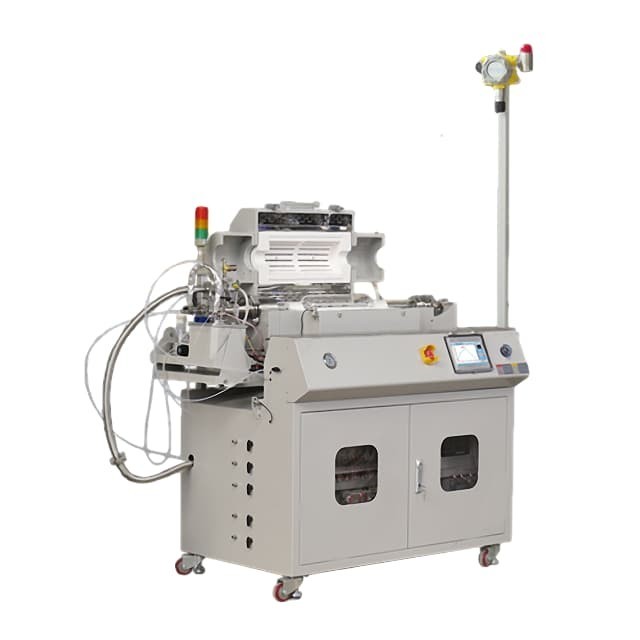
CVD & PECVD Furnace
Custom Made Versatile CVD Tube Furnace Chemical Vapor Deposition CVD Equipment Machine
Item Number : KT-CTF16
Price varies based on specs and customizations
- Max. temperature
- 1600℃
- Temperature control accuracy
- ±1℃
- Vacuum pressure (High vacuum option)
- 6x10-5Pa
Shipping:
Contact us to get shipping details Enjoy On-time Dispatch Guarantee.
Why Choose Us
Reliable PartnerEasy ordering process, quality products, and dedicated support for your business success.
KINTEK's Advanced CVD Tube Furnace: Precision, Versatility, and Customization
Leveraging exceptional R&D and in-house manufacturing, KINTEK provides diverse laboratories and industrial clients with advanced high-temperature furnace solutions. Our extensive product line, including Muffle, Tube, Rotary Furnaces, Vacuum & Atmosphere Furnaces, and specialized CVD/PECVD/MPCVD Systems, is backed by our strong deep customization capability. We are committed to precisely meeting your unique experimental and production requirements.
Product Overview: High-Performance CVD Tube Furnace
The KINTEK Chemical Vapor Deposition (CVD) Tube Furnace is meticulously engineered for processes demanding precise control over temperature, atmosphere, and gas flow. It is ideal for depositing high-quality thin films of various materials, including insulating, metallic, and metal alloy materials, crucial for research and industrial applications. Our CVD furnaces typically feature multiple heating zones for superior temperature uniformity, robust vacuum systems, and sophisticated mass flow gas control stations for accurate precursor delivery. Depending on the configuration, these systems can achieve temperatures up to 1600°C (as in our KT-CTF16-60 model) and vacuum levels down to 6x10-5Pa with high vacuum options.
Key Benefits & Features
Our CVD Tube Furnaces are designed to deliver exceptional performance and reliability for your critical processes:
- Precise Temperature Control & Uniformity: Multi-zone heating (e.g., 3x300mm in KT-CTF16-60) and advanced PID controllers (±1°C accuracy) ensure stable and uniform temperature profiles, essential for consistent film quality.
- Versatile High-Temperature Operation: Capable of reaching high temperatures (e.g., up to 1600°C constant work temperature 1550°C for the KT-CTF16-60 model), suitable for a wide array of CVD processes and material syntheses.
- Advanced Gas Management: Multi-channel Mass Flow Controller (MFC) systems allow for precise mixing and delivery of reactant gases, with high linearity (±0.5% F.S.) and repeatability (±0.2% F.S.).
- Flexible Vacuum & Atmosphere Capabilities: Systems can be configured for various vacuum levels, from standard rotary vane pumps (e.g., 10Pa) to high vacuum molecular pump stations (e.g., 6x10-5Pa), or operate under controlled inert/reactive atmospheres.
- Durable Construction: Utilizes high-purity furnace tubes (e.g., Al2O3) and quality chamber materials (e.g., Alumina polycrystalline fiber) for longevity and process integrity.
- User-Friendly Interface: Options for digital PID controllers or touch screen PID controllers offer intuitive operation, data logging, and easy setup.
- Customizable Design: Tailored to your specific needs, from tube diameter and heating zone length to gas channels and vacuum components.
- Compact & Efficient: Designed to be space-efficient without compromising on performance, making them suitable for various lab and industrial environments.
Technical Specifications (Example: Model KT-CTF16-60)
The following specifications are for our KT-CTF16-60 model. Please note that specifications can be customized to your requirements.
| Furnace model | KT-CTF16-60 |
|---|---|
| Max. temperature | 1600℃ |
| Constant work temperature | 1550℃ |
| Furnace tube material | High purity Al2O3 tube |
| Furnace tube diameter | 60mm |
| Heating zone | 3x300mm |
| Chamber material | Alumina polycrystalline fiber |
| Heating element | Silicon Carbide |
| Heating rate | 0-10℃/min |
| Thermal couple | S type |
| Temperature controller | Digital PID controller/Touch screen PID controller |
| Temperature control accuracy | ±1℃ |
| Gas precise control unit | |
| Flow meter | MFC mass flow meter |
| Gas channels | 3 channels (customizable) |
| Flow rate (Example) | MFC1: 0-5SCCM O2 MFC2: 0-20SCM CH4 MFC3: 0- 100SCCM H2 MFC4: 0-500 SCCM N2 (customizable) |
| Linearity | ±0.5% F.S. |
| Repeatability | ±0.2% F.S. |
| Pipe line and valve | Stainless steel |
| Maximum Operating Pressure | 0.45MPa |
| Flow meter controller | Digital Knob controller/Touch screen controller |
| Standard vacuum unit (Optional) | |
| Vacuum pump | Rotary vane vacuum pump |
| Pump flow rate | 4L/S |
| Vacuum suction port | KF25 |
| Vacuum gauge | Pirani/Resistance silicon vacuum gauge |
| Rated vacuum pressure | 10Pa |
| High vacuum unit (Optional) | |
| Vacuum pump | Rotary vane pump+Molecular pump |
| Pump flow rate | 4L/S+110L/S |
| Vacuum suction port | KF25 |
| Vacuum gauge | Compound vacuum gauge |
| Rated vacuum pressure | 6x10-5Pa |
| Above specifications and setups can be customized | |
Customizable CVD System Configurations
At KINTEK, we specialize in tailoring our CVD furnace systems to your precise research or production needs. Explore some examples of our versatile and customizable setups:

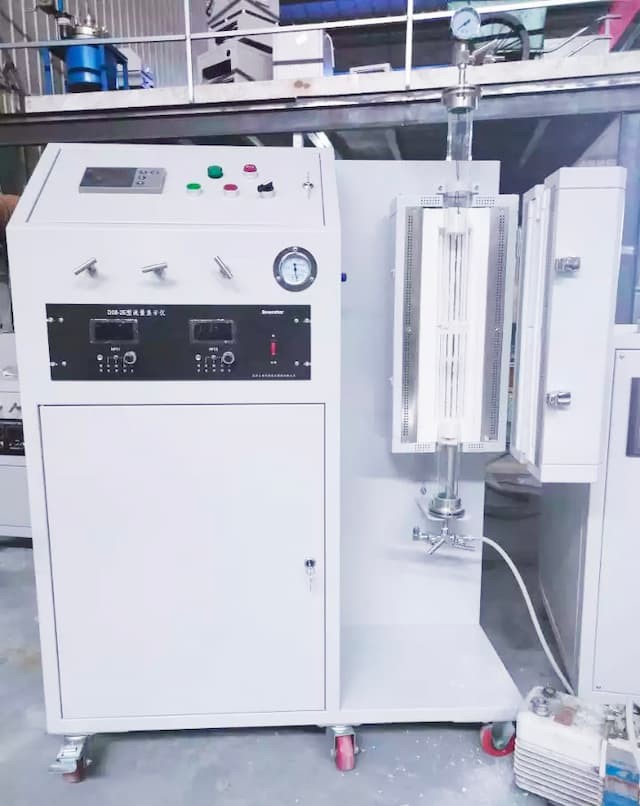
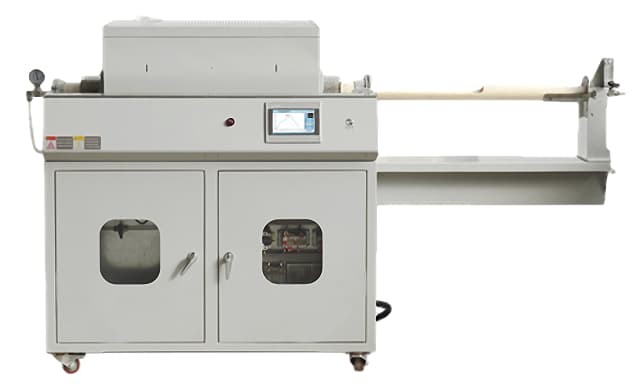

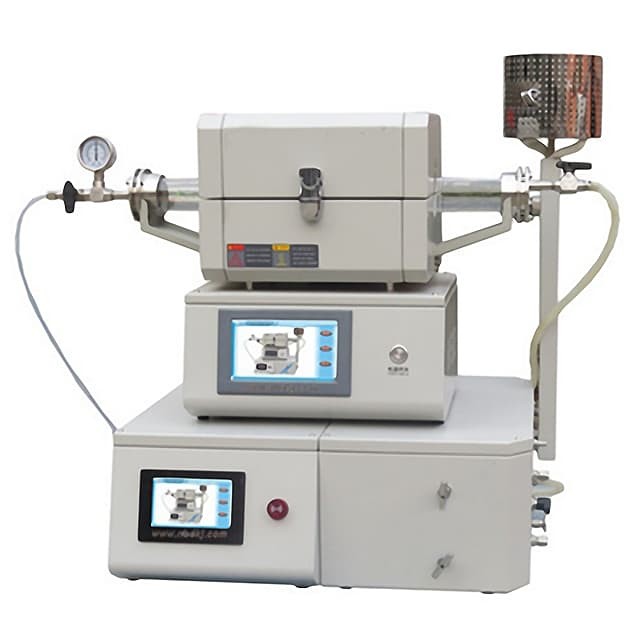
Principle of Operation
Chemical Vapor Deposition (CVD) is a versatile thin film deposition technique where a solid material is formed on a heated substrate from gaseous reactants. In a KINTEK CVD Tube Furnace, the substrate is placed inside a high-purity tube (typically quartz or alumina) and heated to a precisely controlled temperature. A carefully metered mixture of precursor gases is introduced into the tube via a mass flow control system. These gases react or decompose at or near the hot substrate surface, resulting in the deposition of the desired thin film. Key operational aspects include:
- High-Temperature Environment: The furnace creates a stable, high-temperature zone necessary for the chemical reactions.
- Controlled Gas Flow: Mass flow controllers (MFCs) ensure accurate and repeatable delivery of precursor and carrier gases.
- Vacuum or Controlled Atmosphere: A vacuum system removes unwanted contaminants and byproducts, or a controlled atmosphere (inert or reactive) can be maintained to influence the deposition chemistry. Some systems may employ radio frequency (RF) glow discharge or other plasma enhancement techniques for lower temperature deposition or higher deposition rates.
- Uniform Film Growth: Careful design of the heating zones and gas flow dynamics promotes uniform film thickness and composition across the substrate.
This process is widely used in the manufacture of semiconductors, solar cells, protective coatings, nanomaterials, and other advanced electronic and optical devices.
Wide Range of Applications
KINTEK Multi-Zone CVD Tube Furnaces are indispensable tools across various research and industrial sectors:
- Nanomaterial Synthesis: Ideal for growing nanowires, nanotubes (e.g., carbon nanotubes), and preparing nanofilms for advanced materials development.
- Advanced Coating Technologies: Widely used for depositing metal films, ceramic films (oxides, nitrides, carbides), and composite films to enhance surface properties like hardness, corrosion resistance, or conductivity.
- Semiconductor & Electronics: Essential for depositing insulating, semiconducting, and conductive layers in the fabrication of integrated circuits, sensors, and other electronic components.
- Battery Material Processing: Suitable for drying, sintering, and surface modification of battery materials for high-performance energy storage devices.
- High-Temperature Sintering & Annealing: Employed for high-temperature atmosphere sintering, atmosphere reduction, and annealing processes for material densification and property refinement.
- Vacuum & Atmosphere Coating: High vacuum capabilities make it perfect for applications where coating purity and quality are paramount.
- Research and Development: Extensively used in universities and scientific research institutes for fundamental material science studies, including CVD/CVI (Chemical Vapor Infiltration) experiments.
- Plasma Enhanced Processes: Can be adapted for plasma-enhanced CVD (PECVD), plasma cleaning, and etching, expanding its functional versatility.
Standard Package (Example for KT-CTF16-60)
| No. | Description | Quantity |
|---|---|---|
| 1 | Furnace Body with Temperature Control | 1 |
| 2 | High Purity Alumina or Quartz Tube (as per order) | 1 |
| 3 | Vacuum Sealing Flanges with Ports | 2 sets |
| 4 | Tube Thermal Blocks/Plugs | 2 |
| 5 | Tube Thermal Block Hook | 1 |
| 6 | Heat Resistant Gloves | 1 pair |
| 7 | Precise Gas Control Unit (MFCs as per order) | 1 set |
| 8 | Vacuum Unit (Pump & Gauge as per order) | 1 set |
| 9 | Operation Manual | 1 |
Optional Setups & Customizations
Enhance your CVD system with a range of optional features to meet specific experimental needs:
- In-tube gas detection and monitoring systems (e.g., for H2, O2, etc.).
- Independent furnace temperature monitoring and data recording modules.
- RS 485 communication port for PC remote control and data exporting.
- Various gas feeding flow rate control options, including different ranges for mass flow meters and float flow meters.
- Advanced touch screen temperature controllers with versatile, operator-friendly functions (e.g., programmable ramps, data logging).
- Upgraded high vacuum pump station setups, incorporating options like vane vacuum pumps, molecular pumps, or diffusion pumps.
- Liquid/Solid precursor delivery systems (e.g., bubblers, vaporizers).
- Exhaust gas abatement systems.
Partner with KINTEK for Your CVD Solutions
Ready to elevate your research or industrial processes with a state-of-the-art CVD Tube Furnace? The KINTEK team is dedicated to providing you with a system that perfectly aligns with your application requirements, backed by our expertise in high-temperature technology and customization.
Contact us today to discuss your specific needs, explore customization options, or request a detailed quotation. Let us help you achieve unparalleled results in your material deposition endeavors.
FAQ
What Is A Tube Furnace And How Does It Work?
What Are The Main Applications Of Multi-zone Tube Furnaces?
What Is The Principle Of A CVD Machine?
What Is A Vertical Tube Furnace?
What Is A Vacuum Induction Furnace?
What Are The Main Applications Of A Vacuum Furnace?
What Is A PECVD Machine Used For?
What Is An Atmosphere Furnace Used For?
What Are The Main Applications Of Tube Furnaces?
What Are The Key Features Of Multi-zone Tube Furnaces?
What Are The Advantages Of Using A CVD Machine?
What Are The Applications Of A Vertical Tube Furnace?
What Are The Main Applications Of Vacuum Induction Furnaces?
What Are The Key Features Of A Vacuum Furnace?
What Are The Main Types Of PECVD Machines?
What Are The Key Features Of An Atmosphere Furnace?
What Are The Advantages Of Using A Tube Furnace?
How Does A Multi-zone Tube Furnace Work?
What Are The Applications Of A CVD Machine?
What Are The Advantages Of A Vertical Tube Furnace?
How Does A Vacuum Induction Furnace Work?
How Does A Vacuum Furnace Work?
How Does A PECVD Machine Work?
How Does An Atmosphere Furnace Work?
What Types Of Tube Furnaces Are Available?
What Are The Advantages Of Using A Multi-zone Tube Furnace?
What Are The Key Features Of A CVD Machine?
How Does A Vertical Tube Furnace Work?
What Are The Advantages Of Using A Vacuum Induction Furnace?
What Are The Advantages Of Using A Vacuum Furnace?
What Are The Key Features Of A PECVD Machine?
What Are The Advantages Of Using An Atmosphere Furnace?
What Temperature Ranges Can Tube Furnaces Achieve?
What Types Of Multi-zone Tube Furnaces Are Available?
What Types Of CVD Machines Are Available?
What Types Of Vertical Tube Furnaces Are Available?
What Types Of Vacuum Induction Furnaces Are Available?
What Types Of Materials Can Be Processed In A Vacuum Furnace?
What Are The Advantages Of Using A PECVD Machine?
What Types Of Gases Can Be Used In An Atmosphere Furnace?
Can Tube Furnaces Operate Under Different Atmospheres?
Why Choose A Vertical Tube Furnace Over A Horizontal One?
Why Is Temperature Control Important In Vacuum Induction Furnaces?
What Is The Difference Between Hot Wall And Cold Wall Vacuum Furnaces?
What Materials Can Be Deposited Using A PECVD Machine?
What Safety Features Are Available In Advanced Atmosphere Furnaces?
What Makes KINTEK Tube Furnaces Special?
What Temperature Ranges Can Vertical Tube Furnaces Achieve?
What Materials Can Be Processed In A Vacuum Induction Furnace?
Can Vacuum Furnaces Be Customized For Specific Applications?
Why Is PECVD Preferred Over Other Deposition Methods?
Are Vertical Tube Furnaces Customizable?
How Does The Vacuum Environment Benefit Material Processing?
4.9
out of
5
Incredible precision and durability! This CVD furnace exceeded all expectations. Worth every penny!
4.8
out of
5
Fast delivery and top-notch quality. The machine works flawlessly—highly recommend!
4.7
out of
5
A game-changer for our lab! The versatility and performance are unmatched.
4.9
out of
5
Exceptional craftsmanship and advanced technology. Perfect for high-precision tasks.
4.8
out of
5
Superb value for money. The machine is robust and delivers consistent results.
4.7
out of
5
Impressive speed and efficiency. This CVD furnace is a must-have for any serious researcher.
4.9
out of
5
Outstanding performance! The custom features make it stand out from the competition.
4.8
out of
5
Reliable and high-quality. The machine arrived sooner than expected—very pleased!
4.7
out of
5
Perfect for our research needs. The CVD furnace is both powerful and user-friendly.
4.9
out of
5
Top-tier technology at an affordable price. Couldn’t be happier with this purchase!
4.8
out of
5
The machine is a beast! Handles everything we throw at it with ease.
4.7
out of
5
Fantastic investment. The CVD furnace has significantly boosted our productivity.
4.9
out of
5
Absolutely love it! The build quality and performance are second to none.
4.8
out of
5
Quick setup and flawless operation. This machine is a dream come true for our team.
4.7
out of
5
Highly efficient and reliable. The CVD furnace has transformed our workflow.
4.9
out of
5
Exceptional value and performance. This machine is a true workhorse.
4.8
out of
5
The best CVD furnace we’ve used. Delivers consistent, high-quality results every time.
4.7
out of
5
Impressive build and advanced features. A fantastic addition to our lab.
4.9
out of
5
Worth every cent! The machine is durable, efficient, and incredibly versatile.
4.8
out of
5
Fast shipping and excellent customer service. The CVD furnace is a masterpiece!
REQUEST A QUOTE
Our professional team will reply to you within one business day. Please feel free to contact us!
Related Products

Split Chamber CVD Tube Furnace with Vacuum Station CVD Machine
Split Chamber CVD Tube Furnace with Vacuum Station - High precision 1200°C lab furnace for advanced materials research. Customizable solutions available.

Multi Heating Zones CVD Tube Furnace Machine for Chemical Vapor Deposition Equipment
KINTEK's Multi-Zone CVD Tube Furnaces offer precision temperature control for advanced thin film deposition. Ideal for research and production, customizable for your lab needs.

Split Multi Heating Zone Rotary Tube Furnace Rotating Tube Furnace
Precision Split Multi Heating Zone Rotary Tube Furnace for high-temperature material processing, featuring adjustable tilt, 360° rotation, and customizable heating zones. Ideal for labs.

Laboratory Vacuum Tilt Rotary Tube Furnace Rotating Tube Furnace
KINTEK Laboratory Rotary Furnace: Precision heating for calcination, drying, sintering. Customizable solutions with vacuum & controlled atmosphere. Enhance research now!

Laboratory Quartz Tube Furnace RTP Heating Tubular Furnace
KINTEK's RTP Rapid Heating Tube Furnace delivers precise temperature control, rapid heating up to 100°C/sec, and versatile atmosphere options for advanced lab applications.

High Pressure Laboratory Vacuum Tube Furnace Quartz Tubular Furnace
KINTEK High Pressure Tube Furnace: Precision heating up to 1100°C with 15Mpa pressure control. Ideal for sintering, crystal growth, and lab research. Customizable solutions available.

Vacuum Hot Press Furnace Machine Heated Vacuum Press Tube Furnace
Discover KINTEK's advanced Vacuum Tube Hot Press Furnace for precise high-temperature sintering, hot pressing, and material bonding. Customizable solutions for labs.

1700℃ High Temperature Laboratory Tube Furnace with Quartz or Alumina Tube
KINTEK's Tube Furnace with Alumina Tube: Precision heating up to 1700°C for material synthesis, CVD, and sintering. Compact, customizable, and vacuum-ready. Explore now!

Slide PECVD Tube Furnace with Liquid Gasifier PECVD Machine
KINTEK Slide PECVD Tube Furnace: Precision thin film deposition with RF plasma, rapid thermal cycling, and customizable gas control. Ideal for semiconductors and solar cells.

Inclined Rotary Plasma Enhanced Chemical Deposition PECVD Tube Furnace Machine
KINTEK's PECVD coating machine delivers precision thin films at low temperatures for LEDs, solar cells & MEMS. Customizable, high-performance solutions.

1200℃ Split Tube Furnace Laboratory Quartz Tube Furnace with Quartz Tube
Discover KINTEK's 1200℃ Split Tube Furnace with quartz tube for precise high-temperature lab applications. Customizable, durable, and efficient. Get yours now!

Inclined Rotary Plasma Enhanced Chemical Deposition PECVD Tube Furnace Machine
Advanced PECVD Tube Furnace for precise thin film deposition. Uniform heating, RF plasma source, customizable gas control. Ideal for semiconductor research.

Vacuum Sealed Continuous Working Rotary Tube Furnace Rotating Tube Furnace
Precision rotary tube furnace for continuous vacuum processing. Ideal for calcination, sintering, and heat treatment. Customizable up to 1600℃.

RF PECVD System Radio Frequency Plasma Enhanced Chemical Vapor Deposition
KINTEK RF PECVD System: Precision thin-film deposition for semiconductors, optics & MEMS. Automated, low-temperature process with superior film quality. Custom solutions available.

Cylindrical Resonator MPCVD Machine System for Lab Diamond Growth
KINTEK MPCVD Systems: Grow high-quality diamond films with precision. Reliable, energy-efficient, and beginner-friendly. Expert support available.

Spark Plasma Sintering SPS Furnace
Discover KINTEK's advanced Spark Plasma Sintering (SPS) Furnace for rapid, precise material processing. Customizable solutions for research and production.
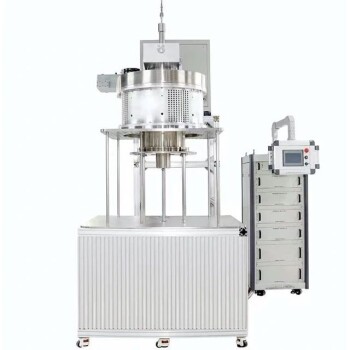
915MHz MPCVD Diamond Machine Microwave Plasma Chemical Vapor Deposition System Reactor
KINTEK MPCVD Diamond Machine: High-quality diamond synthesis with advanced MPCVD technology. Faster growth, superior purity, customizable options. Boost production now!
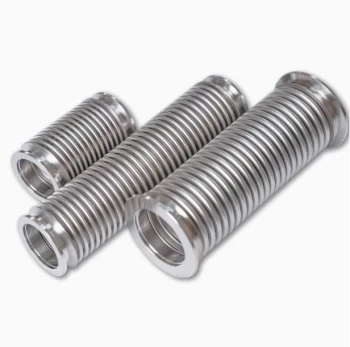
High Performance Vacuum Bellows for Efficient Connection and Stable Vacuum in Systems
KF ultra-high vacuum observation window with high borosilicate glass for clear viewing in demanding 10^-9 Torr environments. Durable 304 stainless steel flange.

HFCVD Machine System Equipment for Drawing Die Nano Diamond Coating
KINTEK's HFCVD system delivers high-quality nano-diamond coatings for wire drawing dies, enhancing durability with superior hardness and wear resistance. Explore precision solutions now!
Related Articles

Why Your Crystal Growth Experiments Are Failing: The Hidden Culprit in Your Tube Furnace
Struggling with inconsistent CVT results? Discover why your tube furnace's temperature gradient, not your chemistry, is the likely culprit and how to fix it.

How CVD Diamond Synthesis Methods Compare for Industrial Applications
Compare CVD diamond synthesis methods (HFCVD, DC Plasma Arc Jet, MPCVD) for cost, quality, and industrial applications like tools, optics, and quantum tech.

Your Furnace Isn't Just a Heater: Why 'Good Enough' Equipment Is Sabotaging Your Advanced Materials Research
Struggling with inconsistent results from your tube furnace? Discover why standard equipment fails and how a modular, customizable approach is key to success.

Why Your Tube Furnace Is Failing Your Experiments (And It’s Not the Temperature)
Discover the hidden reason your high-temperature experiments fail. It's not your process; it's a material mismatch inside your furnace. Learn how to fix it.

Why Your High-Temperature Synthesis Results Are Unreliable—And How to Fix It
Struggling with inconsistent results in material synthesis, CVD, or annealing? Discover the hidden cause of failure is your furnace's environment, not your process.